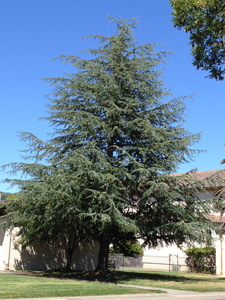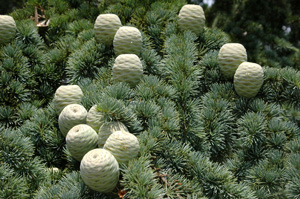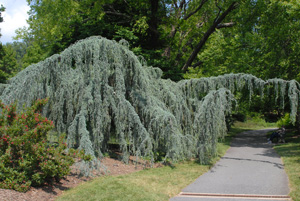Landscape Trees
Atlas Cedar
(Cedrus atlantica)
This is actually one of two cedars that are commonly found in Arkansas landscapes. The other species is the Deodar Cedar (C. deodara). A well maintained, open-grown Blue Atlas Cedar is hard to beat for a specimen evergreen. It has two major attributes going for it: first, the artistic plant habit, especially when young, and second, the eye-popping silver blue needle color. It is fairly common to find two other cultivars of Cedrus atlantica in the retail trade. One is the weeping form of the Blue Atlas Cedar (C. atlantica ‘Glauca Pendula’). The weeping form is like a piece of personal art. It is doubtful that any two plants ever looks the same due the way each plant was grown and trained. The other cultivar of Atlas Cedar that you may find at your local garden center is one of the yellow(-ish) needle forms (e.g. ‘Aurea’). Be cautious of these yellow-needle forms, especially in middle and southern Arkansas, due to a likelihood of needle sun scorch.
In general, Deodar Cedar seems to tolerate the heat of central and south Arkansas better than Blue Atlas Cedar. The further south you go the more you need to provide consistent moisture during the hot summer months. Any of the Cedrus should be provided with ample room so you can appreciate the artistic plant habit. Sapsuckers seem to love to leave their characteristic drilling holes on the trunks of this species.
- Common Name: Atlas Cedar
- Varieties to look for: ‘Glauca’, ‘Glauca Pendula’
- Flower Color: NA
- Blooming period: NA
- Type: needle evergreen
- Size: 55’ tall x 45’ wide
- Exposure: sun
- Soil: prefers moist, acid, deep soils
- Watering: consistent moisture best
- When to prune: NA
- Suggested use: specimen
Form

Fruit and Leaves

Form
